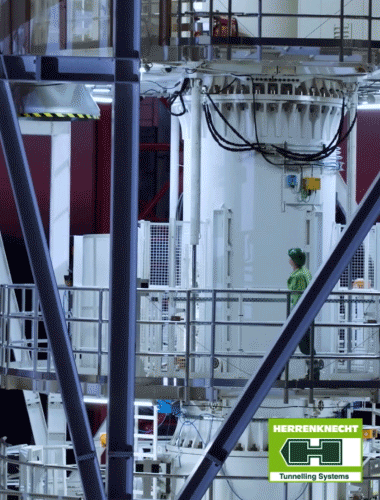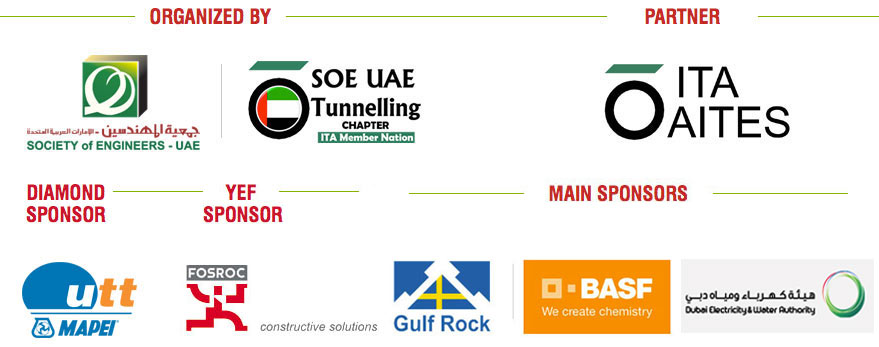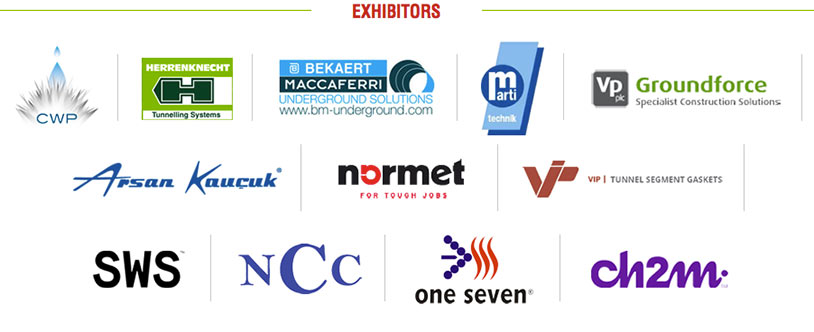Prelude in Dubai for world gathering in 2018 26 Nov 2015
Organisers of the third Arabian Tunnelling Conference and Exhibition in Dubai in November 2015 have a clear goal in sight and that is to strengthen the annual event towards the region’s hosting of the World Tunnel Congress (WTC) and General Assembly of the International Tunnelling and Underground Space Association (ITA) in 2018.
In just three years, the Tunnelling Chapter of the United Arab Emirates Society of Engineers (SOE-UAE), under the auspices of its President, His Excellency Engineer Essa Al Maidoor, has been inducted as the member nation representative of the ITA, hosted three annual conferences and succeeded at the ITA General Assembly at the WTC 2015 in Dubrovnik, Croatia, in a close-run vote with India, and by the ITA Member Nations, to host the WTC and ITA General Assembly in 2018. It is a remarkable development by the Tunnelling Chapter of the SOE-UAE and corresponds with the rapid civil and urban development of the major cities of the UAE and the evident growth in the need for underground facilities and the construction of underground projects in the glittering cities of the Arabian region.
For the third annual event of the series of annual conferences in 2015, the active members of the Tunnelling Chapter of the Society and the conference organising department of the SOE-UAE gathered together a technical programme of leading international speakers, a delegation of high-level officials from various government authorities and private companies of the region, a delegation of approximately 500 registered delegates, an exhibition of international service providers, and a vibrant group of young university civil engineering undergraduates for an introduction to tunnelling and underground space study.
In preparing the technical sessions of the two-day conference, the organisers created a programme that focused specifically on topics that are, and should be, high on the region’s list of underground civil engineering priorities, inviting a group of high-profile keynote speakers to establish the themes and introduce the important issues. The ease of appreciating the programme was helped also by the single track of technical presentations, with the exception of Monday afternoon when key speakers and organisers also hosted a Young Engineers Forum; and by an interactive conference programme that was facilitated by free high-speed wifi internet connection and the fully enabled tablet given to all registered delegates and preloaded also with the full conference proceedings. Most of us can remember two or three heavy volumes of printed proceedings, then the CD of proceedings, and the amazing give-away of USB drives loaded for delivery of the proceedings. To provide a giveaway tablet for the purpose is a true mark of the times and the advance of the Arab region of the world in adopting and driving forward new communications technology.
Two important themes of the conference centred on safety in operating underground facilities and the availability of the underground dimension to provide sustainable solutions to the traffic congestion and harsh climate of the region’s major cities.
In his keynote address, Arnold Dix of Australia and currently based in Qatar, spoke of the vital need to address minimum standards of safety in operating tunnels and underground space. In a video of a fire demonstration in a tunnel laboratory, it was made crystal clear that it is the behaviour of smoke generated by a major fire that causes most fatalities, the enclosed environment becoming quickly filled with thick black smoke that not only poisons the air but completely blacks out visibility. Dix emphasised that minimum standards should be introduced for all road and rail tunnels in the region, and for installing fire life safety facilities, including for the design and signage of escape routes and for the management of sand and water inrush at the portals and entrances to underground space during the heavy rain downpours and sandstorms experienced in the region.
The theme was advanced in presentations by Uwe Klinkhardt, CEO, OneSeven of Germany, about the installation of the company’s foam-based fire extinguishing sprinkler system in the A4 Jagdberg highway tunnel in Germany; and by Erik Neun, Principal Engineer, Coordinator International Projects, EDR GmbH, about optimising structural fire engineering for metro tunnels.
Deep, long, rail tunnels and infrastructure for high speed rail systems was a focus theme with a keynote by Konrad Bergmeister, who is CEO of the procurement authority of the Brenner Base tunnel through the Alps between Austria and Italy. Tim Smart, Director in the UK of the International High Speed Rail, Transportation Business Group for CH2M, described the engineering and operating principles of high speed rail tunnels for HS1 in the UK which has been in operation for some time, and for the HS2 project which is in planning and design and being steered by Smart through its parliamentary approval process.
On a related topic, Paolo Perello, Engineering Geologist of GDP Consultants, raised the question of the reliability of geological forecasts for long and deep tunnels, and whether reliable geological forecasts are possible, using experience gained on relevant rail projects in Italy to illustrate these important points.
The design and construction of tunnels for potable and wastewater networks is a particular focus for the region and it was addressed by several papers and introduced by Martin Knights, Senior Vice President and Managing Director of Tunnels & Earth Engineering for CH2M, through his presentation about the design and construction of the Thames Tideway and Lee Tunnel CSO Programme in London.
Several presentations addressed the design and development of metro and road tunnels. Karin Bäppler of Herrenknecht, Germany, described the growing demand for very large TBM diameters and the technical challenges involved with application of the EPB machine that excavated the Waterview highway project in Auckland, New Zealand; and Jens Classen, Director or Mechanized Tunnelling for Toto Costruzioni Generali relayed the challenges and innovations applied for excavation of the twin-tube TBM-bored Sparvo highway tunnel in Italy.
The excavation of the vital cross passages between twin tube highway and metro tunnels was the focus of a paper by Toby Roberts, Chairman of WJ Groundwater Ltd, who described the use of ground modification methods for depressurisation of cross passage excavation in central London; while in the exhibition area, representatives of SWS at its booth, promoted the use of its specialised TBM application for the full-face mechanical excavation of cross passages through any type of ground conditions and at higher speed than open-face and hand-mining methods.
A particularly interesting presentation was delivered by Davorin Kolic, President of the Tunnelling Society of Croatia, about the historic development of urban pedestrian tunnels and their current vital contribution to sustainable cities. Vast underground urban precincts are being developed in Helsinki, Montreal, Toronto, Hong Kong and Singapore, providing for pedestrian access beneath the wide and congested traffic arteries on the surface, while simultaneously affording shelter from harsh climatic conditions. The need for such pedestrian facilities is particularly evident in the Gulf States region, with city streets creating impassable barriers for pedestrians wanting to cross the urban environment, and with the heat of the desert sun discouraging pedestrian appreciation of the cities. This situation forces everyone into their air-conditioned cars, which further exacerbates the problem. Perhaps the development of high quality, underground, air-conditioned metro stations and networks will provide the core off which underground air conditioned pedestrian environments can spring.
The development, procurement strategy and management of major underground projects is always a topic of high interest at all industry conferences, and in Dubai the issues were addressed by several comprehensive and instructive presentations.
The keynote by Julie Owen, President of AACE International of the USA, described the implementation of the Project Management Office established for the multi-billion dollar underground metro contracts currently being procured by the MRT for the Los Angeles Metro; while another keynote by David Loosemore, President of ICES, delivered a summary of the activities of dispute adjudication boards for tunnelling contracts under the FIDIC forms of contract. Mark Johnson, Regional Tunnel Practice Manager North America for CH2M, concentrated on best practices and lessons learned for adoption of design-build procurement for major tunnel projects; and Amel Siyam and Francois Bernardeau, both of CDM Smith, described the structural and construction challenges experienced during the sinking of shafts on the Abu Hamour surface and groundwater drainage tunnels.
A pdf download of the full conference programme with other interesting and highly relevant presentations for the Middle East audience, is attached to the reference list below. Copies of the proceedings are available from Stephanie Foster, Conference Co-ordinator for the Tunnelling Chapter of the SEO-UAE. A request for the proceeds may not include the tablet delivery vehicle but will be well worth procuring in any format.

TunnelTalk has attended all three ATC events and is a continuing Media Partner of the conference series
On the Monday afternoon, the conference convened another session of its Young Engineers’ Forum. Managed by Edgar Small, Coordinator of Construction Management and Associate Professor of Civil Engineering at the American University in Dubai, and Jurij Karlovsek, Chair, and Petr Salak, Vice Chair of the ITA Young Members Group, the event attracted an attendance of more than 100 young university students in their third year of civil engineering degree courses at eight regional universities. Until the conference none of the students had benefited from any formal introduction to underground space design and development as a civil engineering discipline. Following five presentations about the fundamentals of tunnelling and underground space design and construction, a panel discussion of senior conference delegates addressed questions about how each started their careers in tunnelling; the important issue of internships and apprenticeships; the importance of working for a contractor to gain necessary practical experience of the industry; and the different qualities required for working in the deisgn construction, sales and management sectors of the industry. Everyone at the conference, including all the students, were invited to attend a session on the shotcrete spraying simulator courtesy of BASF, a Gold Sponsor of the event along with one of the region’s main tunnelling contractors: Gulf Rock.
To top off another excellent programme of technical presentations, organisers and hosts prepared three site visits to the Khorfakkan road tunnel in Sharjah; the Dubai Municipality sewerage station and Dubai strategic sewer tunnel project; and the 132kV cable diversion works through service tunnels ST4 and ST5 in Dubai.
After a very enjoyable and informative conference in 2015, we all look forward to joining the SEO-UAE at the 4th and 5th Arabian Tunnelling Conferences & Exhibitions next year; and in 2017 in Dubai and ahead of its premier event of hosting the global tunnelling community at the WTC and ITA General Assembly in 2018.
References
- PDF download of the conference’s technical sessions programme

- Arabian aspirations for greater integration – TunnelTalk, Dec 2013
- Internationals address Arabian delegation – TunnelTalk, Dec 2014
- Reviving the Saudi trans-peninsula rail link – TunnelTalk, September 2013
- Aerodynamics and ventilation in rail tunnels – TunnelTalk, May 2015
- Cross-passage excavation made easy – TunnelTalk, Oct 2015
|
|
|
|
|
Add your comment
- Thank you for taking the time to share your thoughts and comments. You share in the wider tunnelling community, so please keep your comments smart and civil. Don't attack other readers personally, and keep your language professional.







